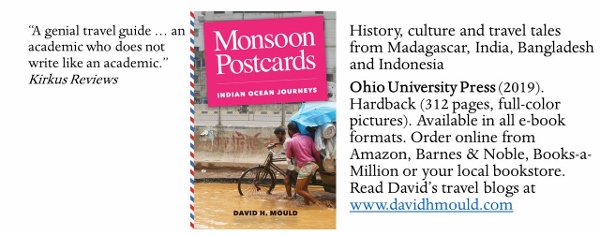The state of Kerala on India’s southwest Malabar coast is justifiably one of the country’s most popular tourist destinations. It’s got everything—palm-lined beaches, backwaters lush with tropical greenery, national parks with elephants and tigers, cool hill stations.
From the Western Ghats, the line of hills that forms the border with Tamil Nadu, the road to the lowlands twists and turns through tea, coffee and spice plantations that divide the hillsides into intricate geometric designs and shapes. After four hours, our Semester at Sea group arrived at the town of Kottayam where we boarded a boat for a three-hour trip along the backwaters to Allepey on the west coast.
Most of this area is below sea level and crisscrossed by waterways used to irrigate the rice paddies. Small houses on narrow levees fringed with coconut palms line the banks. Children were swimming and fishing, and women hanging out clothing to dry; in the middle of the waterway, men were digging sand and loading it into a boat. The rice harvest was under way. Men and women gathered rice stalks and carried them in huge sheaves to the canal bank, where machines separated and husked the rice. It was packed into sacks and loaded onto narrow boats for transportation to the nearest road junction; at one place, we saw men unloading a boat, using ropes and a pulley to move rice sacks to a truck.
Nearer the coast, we started seeing large houseboats. If you can afford it (even in 2003, it was $200 to $400 a day), you can rent a houseboat with a bedroom, covered dining area and other conveniences, and a two-person crew to pilot and cook. Most were occupied by couples, lazing in the late afternoon sun sipping cocktails.
On the bank of the waterway, a red flag fluttered high on a flagpole. In my years of travel in the former Soviet republics of Central Asia it was something I had never seen—the distinctive red flag of the Soviet Union with the hammer and sickle. Earlier in the day, I had seen a hammer and sickle painted on a wall. Later, as we traveled north by bus from Allepey to Kochi (Cochin), the road was temporarily blocked by protestors, again waving red flags.
Since India’s states were created in the late 1950s, largely along linguistic lines, Kerala has been alternately ruled by the Congress Party (the original party of Gandhi and Nehru) and by the Communists. The state has India’s best public health care system and highest literacy rate (over 90 per cent), with newspapers publishing in nine languages, mainly English and Malayalam. Because of Kerala’s tradition of matrilineal inheritance, where the mother is the head of the household, women have a higher standing in society and more legal rights than in other states. Kerala also a broad religious mix, with the largest number of Christians of any Indian state (about 20 per cent of the population). However, unemployment is high, reportedly because businesses fear red tape, state interference and labor stoppages. Indeed, the next day, most of the shops in Kochi were closed because the Communist Party (currently out of power) had called a general strike to protest the police killing of a demonstrator in a protest by indigenous peoples.
Cantilevered Chinese fishing nets have been in use in Kochi for centuries
Kochi was an important spice trading center from the 14th century onward and maintained a trade network with Arab merchants from the pre-Islamic era. It was captured by the Portuguese in the early 16th century, and the explorer Vasco da Gama died there in 1524. The Dutch captured Kochi in the late 17th century, only to be booted out by the British just over a century later. The city is a fascinating cultural mix: the oldest European-built church in India, which switched from Catholic to Calvinist to Anglican as the colonial rulers changed; a 16th century palace built for the local maharajah by the Portuguese in return for trading privileges.
The Jewish quarter, settled by descendants of people who fled Palestine 2,000 years ago, is now reduced (largely by migration to Israel) to a community of less than 20 with a street of shops and a 16th century synagogue.












